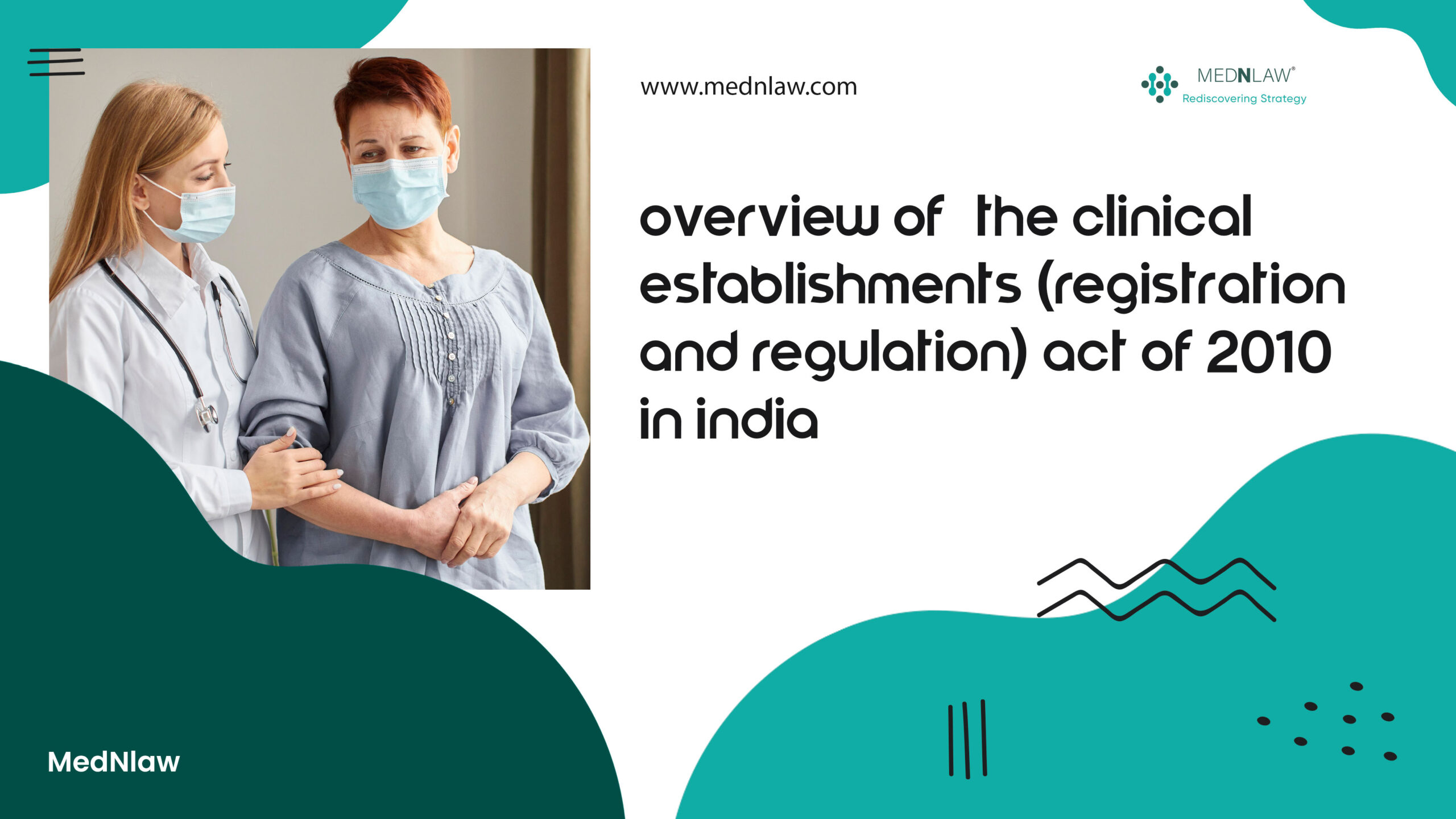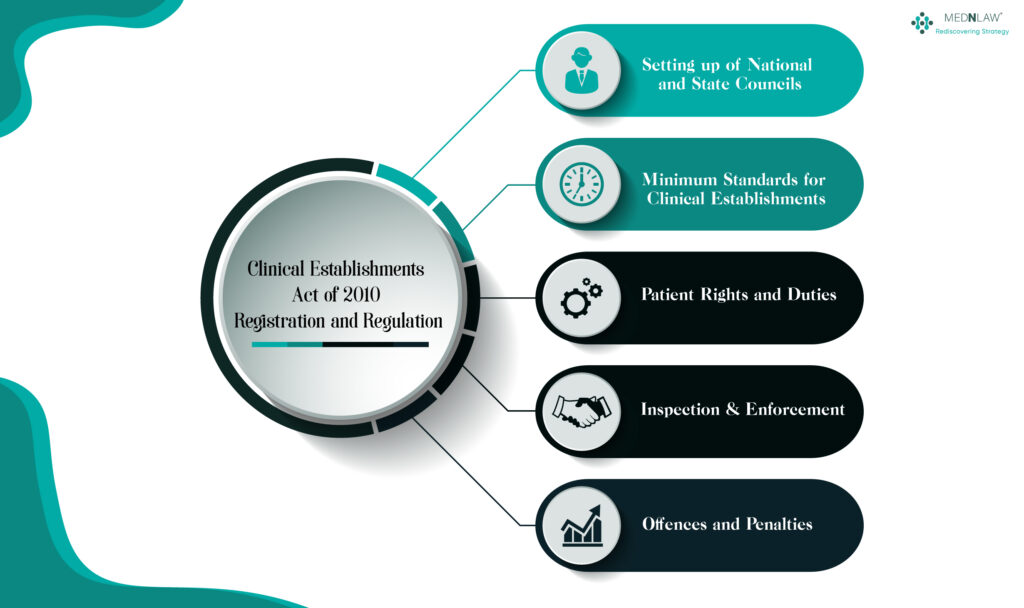
Overview of the Clinical Establishments Act of 2010 in India

Ensuring accurate quality health care delivery was a significant challenge in a vast and hybrid nation like India. India’s healthcare landscape is a tapestry woven with the finest. To ensure a minimum standard of facilities in this sector, the Government of India formulated the Clinical Establishments Act of 2010, to bring about some order, standardisation, and accountability in clinical establishments.
The Clinical Establishments Act of 2010 is historic legislation intended to register and regulate all clinical establishments in the country and prescribe minimum standards for their facilities and services.
In this blog post, we will explore essential details of the Clinical Establishments Act of 2010, its objectives, salient features, implementation challenges, and how it is relevant even today to continue shaping the future of India’s healthcare sector.
Heterogeneity of the Healthcare: Need for Regulation
Before the Clinical Establishments Act of 2010 existed, the regulation of healthcare establishments in India was mainly a fragmented landscape with inconsistent practices. Each state had different rules and regulations, some with no comprehensive laws. The result was huge differences between the level of care, infrastructure and services provided by the other facilities. A central legislation was needed for a few important reasons:
- Understaffing and the Quest for Equitable Health Promotion: Many establishments did not meet basic standards, such as access to facilities or trained personnel; more spartan facilities faced dire conditions.
- Lack of Transparency and Accountability: With the absence of a robust regulatory framework, it was challenging to establish accountability when it came to the quality of services offered by clinical establishments.
- Rights of the patient: The absence of information on standards of care to expect and grievance redressal mechanisms left patients at the mercy of their healthcare providers.
- Data Collection and Planning: In the absence of a national registry of clinical establishments, planning and allocation of healthcare resources were slow and cumbersome.
The Clinical Establishments Act of 2010 aimed to unify the country’s healthcare system and promote a more organised, standardised, and patient-centric system.
Key Objectives of the Act
The Clinical Establishments Act of 2010 is aimed at achieving specific key objectives.
- Registrations of Clinical Establishments: To maintain a complete and detailed registry of all clinical establishments across the country and at the state level to legally document their existence and bring them under the ambit of the law.
- Regulate: To regulate clinical establishments and provide for their registration, the minimum standards of facilities and services they should provide should be determined based on the establishment’s infrastructure, the equipment available, the personnel, and the quality of care being provided.
- Transparency and Accountability: These include ensuring transparency and accountability, which will improve the functioning of clinical establishments and hold them accountable for the services they provide.
- Safeguarding the Rights of Patients: To protect patients’ right to sexual care and the availability of grievance redressal mechanisms.
- Improve Healthcare Planning: To create a national registry and standardise data to ensure better allocation and planning of healthcare.
Key Highlights of Clinical Establishments Act of 2010
The Act provides detailed provisions for the registration and regulation of clinical establishments. The significant features of it are:
Clinical Establishments Act of 2010 aims to any clinical establishment which offers diagnosis and treatment, including nursing, maternity, medical data, and other clinical services; clinical establishment is a vast term; it includes hospitals, nursing homes, and laboratories for diagnosis and other clinical services in addition to dental establishment where treatment is given by any system of medicine recognised by the Indian Medical Council. This broad definition means the vast majority of healthcare providers, even single-doctor clinics, are covered by it. The only significant exception is establishments operated by the armed forces.
Setting up of National and State Councils: The Clinical Establishments Act of 2010 provides for establishing a National Council for Clinical Establishments by the Central Government and State Councils by the State Governments/Union Territories. These councils’ functions include setting minimum standards, maintaining a national and state register, and advising the governments on matters concerning clinical establishments.
Registration of clinical establishments: A key provision of the Clinical Establishments Act of 2010 is the mandatory registration of all clinical establishments. No individual should work in a clinical establishment without getting the proper enlistment. Registration entails satisfying prescribed minimum standards about infrastructure, personnel, equipment and record keeping. A two-tiered registration system is laid out in the Act, consisting of provisional and permanent registration after fulfilling all requirements and standards.
Minimum Standards for Clinical Establishments: Conducting and notifying the minimum of premises in different classes of clinical establishments by the National Council for registration of the clinical establishments based on the services provided in primary, secondary & tertiary care. They include infrastructure, sanitation, waste management, equipment, staffing norms, emergency care and repair of medical record standards.
Patient Rights and Duties: Although not separately mentioned as such, the guiding principle of the Act is the safeguarding of patient rights concerning quality care and access to information. The standards that will be prescribed and the grievance redressal mechanisms indirectly defend patient interests.
Inspection & Enforcement: The Act powers Appropriate Authorities (to be constituted at the district level) to inspect clinical establishments to ensure compliance with prescribed standards. They can issue deficiency notices, impose fines for failure to comply, and suspend or cancel your registration for serious violations.
Offences and Penalties: Similarly, the Act also prescribes penalties for several contraventions, such as running without registration, defaults in any provision, or being below the minimum standards. Such penalties range from fines to, in some cases, incarceration.
Environmental Challenge of the Day
While noble in its aims, its implementation of the Clinical Establishments Act of 2010 has been fraught with hurdles:
States Adoption: The Act is a central legislation, but since healthcare is a state subject, it needs to be defined and adopted by the respective states to come into effect. The Act was adopted by some states and union territories but not by many, resulting in persistent divergences in regulation across the country.
Pushback Among the Medical Fraternity: Some elements of the medical fraternity, especially smaller clinics and individual practitioners, have raised objections regarding the perceived burden of compliance and the possibility of higher costs.
Define and Implement Minimum Standards:Developing and operationalising context relevant minimum standards for the large universe of clinical establishments across its geographies has been a challenging task for the ministry.
Strengthening Enforcement: Focusing on Competence and Resources—Critical to the success of the Act is ensuring that the relevant authorities are properly resourced and have the requisite expertise to adequately inspect and enforce it.
Integrating Awareness and Understanding: A constant effort is made to make healthcare providers and the general public aware of the Act and its impact. Owing to these challenges, many of these states have made significant progress since the implementation of the Clinical Establishments (Registration and Regulation) Act of 2010. The formation of state councils, the continued registration of clinical establishments and the eventual implementation of minimum standards should pave the way for a more regulated and quality-oriented healthcare delivery system in the country.
The Regulator of the Future
The Clinical Establishments Act of 2010 forms an important legal framework for Indian healthcare sector. This is especially timely considering the present one of intensified health care privatisation and a related increasing necessity for quality oversight.
The future of healthcare regulation in India — what lies ahead:
- More States Adopting the Act: Additional work to add more states to the list of those adopting and implementing the Act.
- Revised and Updated Minimum Standards:The authorities must update and revise the standards.
- Enhanced Stake on Patient Rights: Enhanced provisions with regard to the patient rights concerning reasonable information, informed consent, and grievance redressal
- Provisions Related to Integration with Digital Health Initiatives:Harmonization of the Act with the Ayushman Bharat Digital Mission (ABDM) for a standardised platform on data interoperability.
- Increased Focus towards Quality Accreditations: To raise standards, we need to encourage clinical organisations to achieve quality accreditations from recognised bodies.
Conclusion
Clinical Establishments Act of 2010, is a landmark move to work towards a more accountable and quality healthcare system in India. The implementation has faced few problems. These tenets, namely, ensuring minimum standards, protecting patients’ rights and encouraging transparency, are the key. The ramifications of this Act are transformative implications that may change how healthcare unfolds in India as the country progresses towards universal access and quality medical care. Regulation is a work in progress, and it will continue to emerge and evolve through a process of consultation and consensus amongst all stakeholders who collaborate towards the shared vision of quality care for every Indian.
-
 Overview of the Clinical Establishments Act of 2010 in India8:05 am GMT+00:00•April 28, 2025Read more
Overview of the Clinical Establishments Act of 2010 in India8:05 am GMT+00:00•April 28, 2025Read more -

-

Here are some related articles you may find interesting
-

-

-

-

-
 Healthcare License Renewals in India: Everything You Should Know8:05 am GMT+00:00•March 19, 2025Read more
Healthcare License Renewals in India: Everything You Should Know8:05 am GMT+00:00•March 19, 2025Read more -

Copyright Mednlaw



